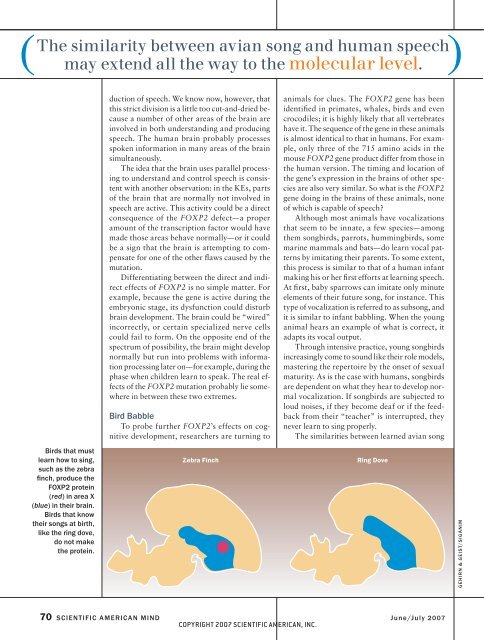Scientific American Mind-June/July 2007
Scientific American Mind-June/July 2007
Scientific American Mind-June/July 2007
You also want an ePaper? Increase the reach of your titles
YUMPU automatically turns print PDFs into web optimized ePapers that Google loves.
( The similarity between avian song and human speech )<br />
may extend all the way to the molecular level.<br />
Birds that must<br />
learn how to sing,<br />
such as the zebra<br />
fi nch, produce the<br />
FOXP2 protein<br />
(red) in area X<br />
(blue) in their brain.<br />
Birds that know<br />
their songs at birth,<br />
like the ring dove,<br />
do not make<br />
the protein.<br />
duction of speech. We know now, however, that<br />
this strict division is a little too cut-and-dried because<br />
a number of other areas of the brain are<br />
involved in both understanding and producing<br />
speech. The human brain probably processes<br />
spoken information in many areas of the brain<br />
simultaneously.<br />
The idea that the brain uses parallel processing<br />
to understand and control speech is consistent<br />
with another observation: in the KEs, parts<br />
of the brain that are normally not involved in<br />
speech are active. This activity could be a direct<br />
consequence of the FOXP2 defect—a proper<br />
amount of the transcription factor would have<br />
made those areas behave normally—or it could<br />
be a sign that the brain is attempting to compensate<br />
for one of the other fl aws caused by the<br />
mutation.<br />
Differentiating between the direct and indirect<br />
effects of FOXP2 is no simple matter. For<br />
example, because the gene is active during the<br />
embryonic stage, its dysfunction could disturb<br />
brain development. The brain could be “wired”<br />
incorrectly, or certain specialized nerve cells<br />
could fail to form. On the opposite end of the<br />
spectrum of possibility, the brain might develop<br />
normally but run into problems with information<br />
processing later on—for example, during the<br />
phase when children learn to speak. The real effects<br />
of the FOXP2 mutation probably lie somewhere<br />
in between these two extremes.<br />
Bird Babble<br />
To probe further FOXP2’s effects on cognitive<br />
development, researchers are turning to<br />
animals for clues. The FOXP2 gene has been<br />
identifi ed in primates, whales, birds and even<br />
crocodiles; it is highly likely that all vertebrates<br />
have it. The sequence of the gene in these animals<br />
is almost identical to that in humans. For example,<br />
only three of the 715 amino acids in the<br />
mouse FOXP2 gene product differ from those in<br />
the human version. The timing and location of<br />
the gene’s expression in the brains of other species<br />
are also very similar. So what is the FOXP2<br />
gene doing in the brains of these animals, none<br />
of which is capable of speech?<br />
Although most animals have vocalizations<br />
that seem to be innate, a few species—among<br />
them songbirds, parrots, hummingbirds, some<br />
marine mammals and bats—do learn vocal patterns<br />
by imitating their parents. To some extent,<br />
this process is similar to that of a human infant<br />
making his or her fi rst efforts at learning speech.<br />
At fi rst, baby sparrows can imitate only minute<br />
elements of their future song, for instance. This<br />
type of vocalization is referred to as subsong, and<br />
it is similar to infant babbling. When the young<br />
animal hears an example of what is correct, it<br />
adapts its vocal output.<br />
Through intensive practice, young songbirds<br />
increasingly come to sound like their role models,<br />
mastering the repertoire by the onset of sexual<br />
maturity. As is the case with humans, songbirds<br />
are dependent on what they hear to develop normal<br />
vocalization. If songbirds are subjected to<br />
loud noises, if they become deaf or if the feedback<br />
from their “teacher” is interrupted, they<br />
never learn to sing properly.<br />
The similarities between learned avian song<br />
Zebra Finch Ring Dove<br />
70 SCIENTIFIC AMERICAN MIND <strong>June</strong>/<strong>July</strong> <strong>2007</strong><br />
COPYRIGHT <strong>2007</strong> SCIENTIFIC AMERICAN, INC.<br />
GEHIRN & GEIST/SIGANIM

















